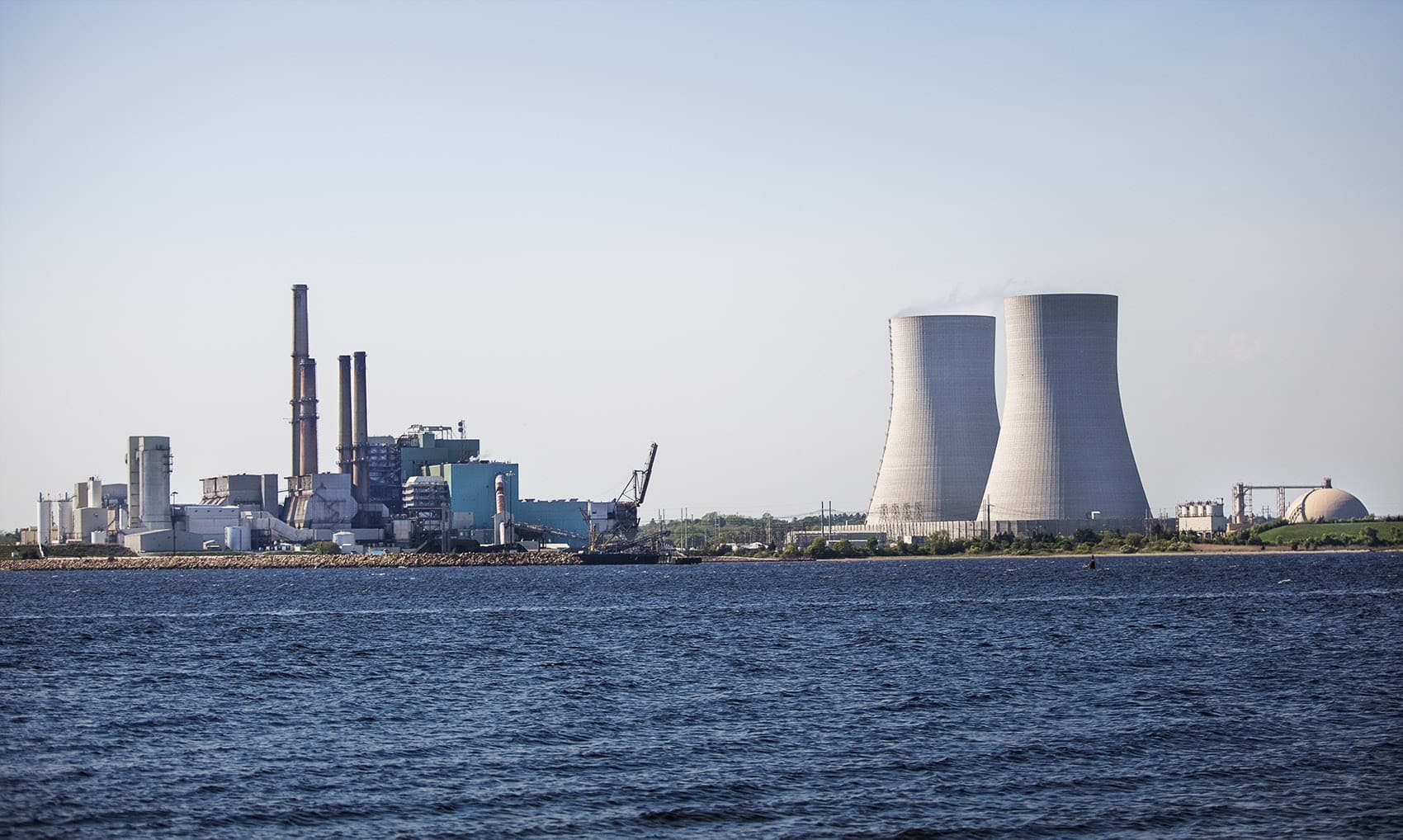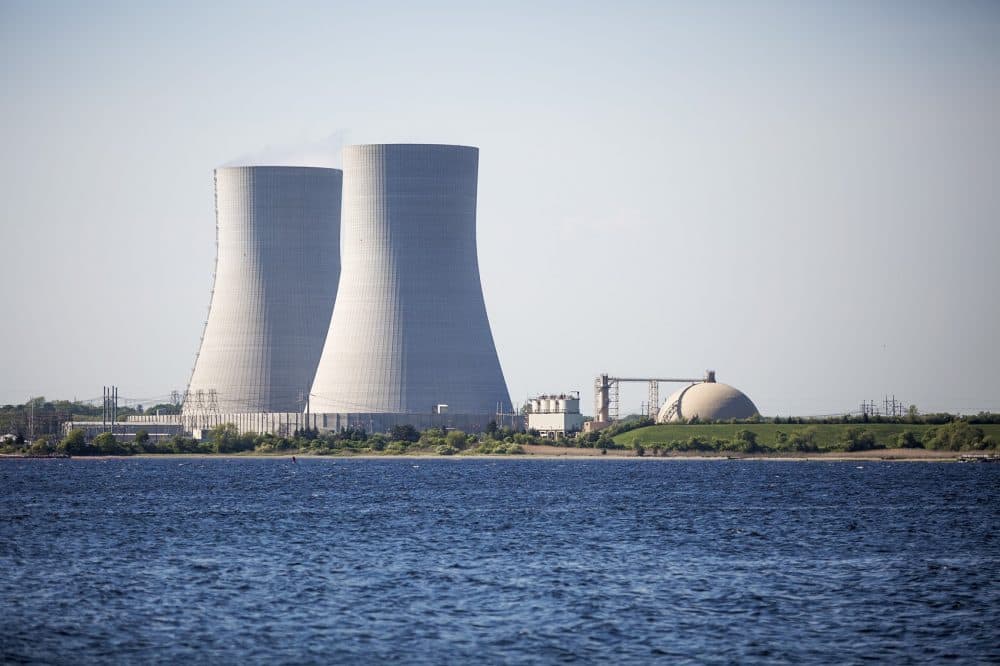Advertisement
In Somerset, Last Coal-Burning Power Plant In Mass. Shuts Down
Resume
The last coal-fired power plant in Massachusetts — and the largest in New England — shuts down for good on Wednesday.
For more than 50 years, the massive Brayton Point Power Station in Somerset has generated electricity fueled by shiploads of coal from as far away as Colombia and South Africa.
The shutdown marks a victory for environmentalists, but pulling the plug on the plant leaves a huge hole in Somerset's tax base and an even bigger problem for ratepayers across the region.
Once An Industry Powerhouse
The marshland deepwater port at the southern tip of Somerset has been the site for coal shipments for 150 years. The black rock helped power a young nation's trains and the industrial revolution. It fueled its optimism.
Brayton Point's two cement cooling towers — each soaring 500 feet high — loom in the distance across Mount Hope Bay. For state Rep. Pat Haddad, the bay's name is now a misnomer.
"It’s very melancholy because what it represented to the town of Somerset for a very long time was an industry that was responsible for a large portion of the tax base," she said. "Now, when I look at it, I see the future, and the future right now isn't very bright."
In its heyday, hundreds of workers stoked the coal-burning boilers at Brayton Point. The plant generated enough electricity to power 1.5 million homes and fueled Somerset's schools and services with $13 million a year.
But, for the past decade, it's produced a declining fraction of the power and funds. Many area residents worry about what will happen when the plug is finally pulled on the plant on Wednesday.
"It’s very melancholy because what it represented to the town of Somerset for a very long time was an industry that was responsible for a large portion of the tax base. Now, when I look at it, I see the future, and the future right now isn't very bright."
state Rep. Pat Haddad
But some, like Lloyd Mendes, hold different priorities to move the town forward.
"What do I do?" Mendes said. "I'm a nudnik in town." Mendes is retired. He recently ran unsuccessfully for Somerset selectman. He proposed unpopular solutions to save money after the shutdown, including deep spending cuts, reducing school bus service and eliminating the Blue Raiders high school hockey program.
"I love hockey," he said. "I recognize these kids are a unique bunch of kids — maybe some of them are at risk. I mean, it's a wonderful sport, but we cannot afford $1,500 per kid, for any activity."
Mendes lives near Mount Hope Bay in the shadow of the Brayton Point cooling towers.
"I have kayaks; I got a sailboat; I shellfish," he lists. "It's a beautiful place, and the fact that it's next to industry, well, I live in the industrial age. I got no problem with that. Nobody owes you a living. It's up to you to make things work.
"And don't forget the Sierra Club didn't force them out. They made a business decision," Mendes added.

Its Closing: Environmental Opposition And Maybe Disingenuous Dealing
Environmental demonstrators tried for years to shut Brayton Point down.
The coal plant was the state's number one emitter of toxins into the environment, and hot water discharged into the bay was killing fish. A decade ago, plant owner Dominion Energy spent a $1 billion to clean up its act and comply with court rulings, but it was too little too late.
Peter Shattuck, director of the Acadia Center's Clean Energy Initiative, says Dominion didn't realize there was a revolution going on in energy production — away from coal to natural gas, renewable resources and efficiency.
"The owners really got caught flatfooted, though," he said. "They put a ton of money into that facility and basically had to drop it a couple of years later."
In 2014, Dominion sold Brayton Point to the private equity firm Energy Capital Partners. The company, based in New Jersey but incorporated in the Cayman Islands, bought the plant and two others for less than half the price Dominion paid for the environmental improvements.
And then, just six weeks after the deal closed, Energy Capital Partners announced it was closing Brayton Point in three years.
"You know, it’s still a mystery," Rep. Haddad said. "Very many of us have the conjecture that the group that bought the plant from Dominion really had no plan to run it. For them, it just meant: How quickly can we move it along and how much can we make?"
Tyson Slocum, director of the energy project at the consumer advocacy organization Public Citizen, investigated the strange deal.
"Energy Capital Partners was able to make a lot more money selling less power," he said. "They knew that when the bought Brayton Point."
Slocum charges Energy Capital Partners deliberately manipulated the wholesale market for electricity, single-handedly turning the region's energy supply from a surplus to a deficit.
"Their whole plan was to buy Brayton Point so that they could prematurely close it in order to create an artificial shortage to drive prices up," he explained. "Prices went up by more than a billion dollars — a huge price increase — all to be paid for by New England ratepayers. It's exactly what Enron did."
Energy Capital Partners did not respond to numerous attempts to discuss the Brayton Point deal.
The Federal Energy Regulatory Commission reviewed the case. Two of four commissioners raised concerns about market manipulation, but because of the split didn’t pursue further investigation.
ISO New England manages the region's wholesale electricity market. Spokeswoman Anne George declined to discuss specifics about Brayton Point but said the market responded as expected.
"That's what markets do when they see a shortfall," she said. "The prices rise to show the need for investment."
Power generators wanted to invest in more natural gas power plants. Bargain basement prices for fracked gas were driving other energy sources out of the market.
George says closing the Brayton Point coal plant creates even greater demand for gas: "And, so you take away a large non-gas resource that just adds to the pressure on the natural gas system."
An Energy Future Facing The Wind
In the year 2000, coal supplied 12 percent of New England's electricity. Now, it's just 3 percent. And natural gas, which generated less than 20 percent of the region's energy back then, now provides nearly 60 percent. The ISO says we need more natural gas and more pipelines to carry it to ensure the reliable supply of electricity.
"We're putting all of our eggs in a big natural gas basket, and it's risky."
Peter Shattuck, director of the Acadia Center's Clean Energy Initiative
"We're putting all of our eggs in a big natural gas basket, and it's risky," said Shattuck, of the Acadia Center.
He warns we've become dangerously over-reliant on natural gas to generate electricity, adding that we need to look to alternatives.
"Brayton is a once-in-a-lifetime opportunity to show we can go straight from coal to clean energy," Shattuck said. "We know how to do this. We have the tools: offshore wind, energy storage — these are the technologies of the future. We just need to use them in a smart way to make the grid stronger."
Haddad had once been the biggest booster of Brayton Point, but now, she is a convert.
"You know, when I saw the handwriting on the wall, I realized that, honey, you got to get off the train or it's going to be wrecked," she said.
Massachusetts is now mandating new offshore wind farms produce as much electricity as the coal-fired power plant once did. Haddad wants to use Brayton Point as a support site for the offshore wind farms.
"Wind makes so much sense," she said. "I mean, it's 300-plus acres on the water. We're a designated deepwater port. What we have for transmission lines, I think the opportunities are there.
"So, yes, I'm the schizophrenic. I was the queen of coal, and now I'm the witch of wind," she added, laughing.
As the sun sets Wednesday on the old Somerset coal-fired powered plant, state officials will be meeting to assess three sites in the running to be the hub of the new offshore wind industry, including Brayton Point.
This article was originally published on May 31, 2017.
This segment aired on May 31, 2017.
